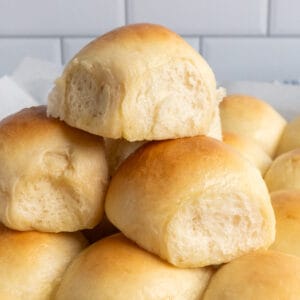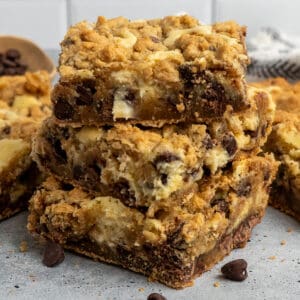This Easy Homemade Rolls Recipe is here to make your dinner table even more inviting. With simple ingredients and straightforward instructions, dinner rolls are a breeze to make from scratch in your own kitchen and will enhance any meal with a homemade taste!

Dinner rolls are small, soft, and fluffy bread rolls that serve as the perfect accompaniment to any hearty meal. Their light and tender texture pairs beautifully with savory dishes, making them a perfect addition to any main course or side dish!
Though you can buy dinner rolls fresh or frozen in any grocery store, they’re easy to make from scratch using less than ten easy-to-find ingredients! You don’t need to be a professional baker to make dinner rolls at home. Mix softened butter, sugar, eggs, milk, and salt in a stand mixer, followed by a bubbly yeast mixture. Let the dough rise once before shaping them and placing in a buttery base. After a second rise, they bake until tender, warm, and golden brown on the top.
These easy dinner rolls are a versatile addition to any occasion, making them extra special with a homemade touch. Whether it's Christmas, Thanksgiving, or any other holiday celebration, these soft, buttery rolls grace your table and make any meal complete. Serve them alongside meatloaf, Mississippi chuck roast, or use them to soak up Easy Taco Soup Recipe!
Why You’ll Love This Recipe
- Homemade dinner rolls are incredibly soft and fluffy, with a delicate buttery flavor that screams comfort.
- With these clear step-by-step instructions, even beginner bakers can confidently create these rolls, adding a homemade touch to their meals.
- The aroma of freshly baked bread fills your kitchen as these rolls rise and bake, adding another layer of enjoyment.
- They are a perfect complement to a wide range of dishes, making them a versatile addition to any meal.

Ingredients You’ll Need
- Yeast - Serves as the leavening agent in this recipe, helping the dough rise and become airy and light.
- Granulated Sugar - Adds sweetness to the dough while also providing nourishment for the yeast during the proofing process.
- Salt - Enhances the overall flavor of the rolls, balancing out the sweetness and adding depth to the taste.
- Salted Butter - Contributes richness and a creamy texture to the dough, infusing it with a delightful buttery flavor.
- Eggs - Act as a binding agent, helping to hold the dough together while also providing moisture and structure to the rolls.
- Warm Milk - Lends moisture to the dough, resulting in a softer and more tender texture in the finished rolls.
- Flour - The primary dry ingredient that forms the structure of the rolls, providing the necessary gluten for their texture and shape.
- Warm Water -Used to activate the yeast, initiating the fermentation process essential for the dough's rise and development.
How To Make Homemade Dinner Rolls
Activate the yeast: Add warm water, yeast, and 2 tbsp of sugar to a small bowl. Set aside and wait for the yeast to proof (or bubble). This will take 5-10 minutes.
Mix the wet ingredients: Using your stand mixer with the whisk attachment, mix together the butter and sugar until creamy. Add the milk, eggs, and salt, and mix until well combined. Then, add the yeast mixture and mix until combined.
Add the flour: Switch the attachment to the dough hook. While the mixer is on low, slowly add 1 cup of flour at a time, mixing well between each cup. Mix the dough for 4-5 until the dough pulls away from the sides of the bowl and starts to form a ball. Be careful not to add too much flour.
Let the dough rise: Cover the bowl using either a clean dish towel or plastic wrap sprayed with cooking spray. Set aside and let the dough rise until it doubles in size.
Prepare for baking: Preheat your oven to 350℉. Line a baking sheet with parchment paper and set aside.
Melt 4 tablespoons of additional butter in the microwave in 10-second intervals until the butter is completely melted. Pour the butter evenly onto the bottom of the line baking sheet.
Shape and rise: Roll the dough into 20 evenly sized balls and place them on the prepared baking sheet with butter. Cover with a towel and set aside for another 45-60 minutes or until rolls have risen again.
Bake and enjoy: Uncover and bake the rolls for 15-18 minutes or until they turn slightly golden brown. Melt the remaining 4 tbsp of butter and brush it on top of the warm rolls. Serve warm and enjoy!

Recipe Tips
- Use a kitchen thermometer to ensure your milk and water are at the correct temperature. Warm milk should be around 110°F (43°C), and warm water should be slightly warmer at about 115°F (46°C) to activate the yeast properly.
- When proofing the yeast, check for a frothy, bubbling surface after 5-10 minutes. This indicates that the yeast is active and ready to use; if not, your yeast may be expired.
- Soften the salted butter to room temperature before mixing to ensure it incorporates smoothly into the dough.
- Gradually add flour to the dough, allowing each cup to fully incorporate before adding more. This prevents adding too much flour, which can result in dry rolls.
- When letting the dough rise, cover it with a clean dish towel or plastic wrap sprayed with cooking spray to prevent sticking.
- To speed up the rising process, place the covered dough in a warm, draft-free spot in your kitchen.
- When shaping the rolls, aim for equal-sized portions to ensure even baking.
- For a gorgeous golden finish, don't skip brushing the rolls with melted butter immediately after taking them out of the oven.
Serving Suggestions
- Thanksgiving Feast - Serve warm dinner rolls alongside roasted turkey, gravy, and all the traditional Thanksgiving sides for a classic holiday meal.
- Soups and Stews - Pair dinner rolls with a hearty bowl of soup or stew to soak up the flavorful broth and add a satisfying texture.
- BBQ or Grilled Meats - Enjoy dinner rolls as a side with barbecued ribs, pulled pork, or grilled burgers for a delightful contrast of flavors and textures.
- Pasta Dishes - Serve dinner rolls with pasta dishes like spaghetti or lasagna to round out the meal with some comforting carbs.
- Pot Roast - Place a tender pot roast inside a sliced dinner roll, drizzle with gravy, and enjoy a savory, handheld delight.
- Holiday Brunch - Include dinner rolls in your brunch spread, serving them alongside quiches, frittatas, and assorted breakfast items.

Storing & Freezing
Storing: To store homemade dinner rolls, place them in an airtight container or resealable plastic bag at room temperature for up to 2-3 days. If you want to keep them fresh for longer, store them in the refrigerator for up to one week.
Freezing: For freezing, wrap the individual dinner rolls tightly in plastic wrap or aluminum foil, then place them in a freezer-safe container or zip-top bag. They can be frozen for up to 2-3 months. When ready to enjoy, thaw them at room temperature or reheat in a 350°F (175°C) oven for 10-15 minutes until heated through and soft.
FAQ
The best way to reheat dinner rolls is to place them in a 350°F (175°C) oven for about 10 minutes. This will help them regain their warmth and soft texture without becoming soggy or overcooked.
Homemade rolls can become tough if they are overworked during the kneading process or if too much flour is added, resulting in an excess of gluten development. To ensure tender rolls, avoid overmixing the dough and add flour gradually as needed.
Dinner rolls can appear shiny when brushed with melted butter or an egg wash before baking. This not only adds a beautiful golden sheen to the rolls but also enhances their flavor and aroma.

More Easy Side Dishes
- Quick & Easy Sheet Pan Breadsticks
- Easy Oven Roasted Potatoes
- Authentic Hawaiian Macaroni Salad
- Best Potato Salad Recipe
- Best Classic Italian Pasta Salad Recipe
SHARE IT & RATE IT
I would love it if you would leave a 5 Star ⭐️⭐️⭐️⭐️⭐️ rating below. Then follow me on Facebook, Instagram, and Pinterest! Share your favorite recipes or ask questions in my Facebook Group.

Easy Homemade Dinner Rolls Recipe
Ingredients
- 1½ tbsp yeast
- 2 tbsp granulated sugar
- 1 tsp salt
- 8 tbsp salted butter room temperature
- ⅓ cup sugar
- 3 eggs
- 1 cup milk warmed
- 4½-5 cups flour
- ¼ cup warm water
Butter for Baking Rolls
- 8 tbsp melted butter 4 tbsp for the bottom of the pan, and 4 tbsp to brush on top of the baked rolls.
Instructions
- Add warm water, yeast, and 2 tbsp of sugar to a small bowl. Set aside and wait for the yeast to proof (or bubble). This will take 5-10 minutes.
- Using your stand mixer with the whisk attachment, mix together the butter and sugar until creamy. Next, add the milk, eggs, and salt, and mix until well combined. Now, add the yeast mixture.
- Switch the attachment to the dough hook. While the mixer is on low, slowly add 1 cup of flour at a time, mixing well between each cup. Mix the dough for 4-5 until the dough pulls away from the sides of the bowl and starts to form a ball. Be careful not to add too much flour.
- Cover the bowl using either a clean dish towel or plastic wrap sprayed with cooking spray. Set aside and let the dough rise until it doubles in size.
- Preheat your oven to 350℉. Line a baking sheet with parchment paper and set aside.
- Melt 4 tbsp of the additional butter in the microwave in 10-second intervals until the butter is completely melted. Pour the butter evenly onto the bottom of the line baking sheet.
- Roll the dough into 20 evenly sized balls and place them on the prepared baking sheet. Cover with a towel and set aside for another 45-60 minutes or until rolls have risen.
- Uncover and bake the rolls for 15-18 minutes or until they turn slightly golden brown. Melt the remaining 4 tbsp of butter and brush it on top of the warm rolls.
- Serve and enjoy!
Notes
- Use a kitchen thermometer to make sure your milk and water are the right temperature. The milk should be around 110°F (43°C), and the water a tad warmer, at about 115°F (46°C), to get the yeast going.
- Let the salted butter reach room temperature before mixing it in to make sure it blends smoothly into the dough.
- When making homemade rolls, they can get tough if you over-knead the dough or add too much flour, causing too much gluten to form. To keep your rolls soft and tender, don't overmix the dough, and add flour little by little as necessary.
Nutrition
*All nutrition information provided is automatically calculated and is an estimate and will vary based on ingredients, brands, and changes in cooking methods listed in the recipe. If you need exact numbers on your ingredients, I would recommend calculating them with your prefered nutrition calculator.





Leave a Reply